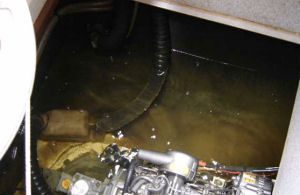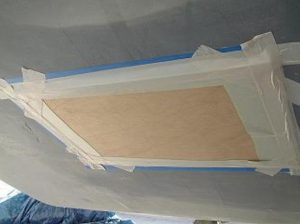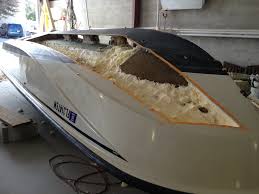How To Repair Fiberglass Boat Hull From The Outside
Disclaimer: As an affiliate I may earn a committee on any qualifying purchases, including those from Amazon.com, at no extra cost to you – read more than.
Yous're out for a day of cruising in your new boat, weaving in and out of islands on your favorite lake. Subsequently a long day out on the h2o, you turn around to head back to the boat launch, only to hear the dreaded scraping and crunching of your gunkhole against a shallow rock. Your heart sinks as you lot call back of all the time and money it will take to repair your gunkhole if you send it into the shop.
But what if you could repair your fiberglass boat hull all on your own? Audio crazy? It shouldn't. While fiberglass boat repairs are a scrap more complicated than those you'd find on wooden boats, almost small dings, scratches, and even small holes are, indeed, repairable. To help y'all become started, nosotros've got the ultimate guide to repairing a fiberglass boat hull from the outside, complete with tips and tricks to aid get your boat back on the h2o in no time flat.
- How To Discover a Leak in a Fiberglass Gunkhole
- Identifying a Small Leak
- Finding the Source of a Leak
- How to Repair a Fiberglass Boat Hull
- Emergency vs Long-Term Repairs
- Emergency Repairs
- Does Flex Seal Piece of work on Fiberglass Boats?
- Long-term Repairs
- Emergency Repairs
- In-H2o vs Out-of-Water Repairs
- In-Water Repairs
- Out-of-Water Repairs
How To Find a Leak in a Fiberglass Boat
While some holes in boat hulls are caused by a catastrophic collision, many more seemingly come up from nowhere. Often, these modest leaks build upward over time so slowly that you don't know it'due south happening until it really does. This kind of progressive pigsty development can be scary, particularly since water can commencement coming into your boat without giving indicators equally to how or why got in there.
Identifying a Small Leak

If you've got a leaky gunkhole, you start need to figure out where the leak is coming from, which can be trickier than it seems. That beingness said, at that place are some telltale signs of a leak that often happen before water starts flooding into your boat.
Often, with leaks, prevention or early intervention is primal to reducing potential damage. Every in one case in a while, you'll want to go around and inspect your boat, but to check to run into how things are doing and if there are any minor issues that you tin can chop-chop set up.
When it comes to leaks, look for paint bubbling or breaking downwardly near an overhead or deck on the boat's interior. You lot might also observe discoloration or corrosion on some of your metallic fixings. If some of your fixings have this upshot and not others, you may accept a leak on your hands.
Finding the Source of a Leak
One time you place that your boat is leaking, it's now time to identify the source of the leak. There are a few dissimilar methods that you can use, so let'south expect at a few of them hither for holes above the waterline:
- If yous have a buddy, you tin enquire them to stand inside your boat as yous get a hose with a spray zipper. In one case you have your hose ready, brainstorm spraying water onto your boat, starting away from the suspected hole site and moving slowly toward information technology. Your friend on the inside of the boat tin can alert you when they start seeing water. Voila! You've got your leak.
- Should water not be an appropriate method for identifying a leak in your boat, you can try to use a tin of compressed air. Showtime by sprinkling some baby pulverization onto the outside of your boat and then use the compressed air to accident on the location from the inside. If you've found the source of the leak, you'll probably find a disturbance in the baby powder on the outside of the boat.
- If y'all want to go fancy, you can besides get yourself an ultrasonic leak detector to find your leak. This technology basically transmits soundwaves through your gunkhole and uses that information to identify where there might be a hole in your gunkhole. That's some pretty absurd stuff.
All of those methods are fine and keen for leaks to a higher place the waterline, but what do you lot exercise if the hull of your gunkhole is leaking? Here are some suggestions:
- First and foremost, unless the source of the leak is obvious (east.g., a large hole), you'll desire to start by completely drying out the bilge. Y'all can practise this past letting your bilge pump do its job and and then going in after it'south finished with a sponge and some towels to dry the place out properly.
- In your fiberglass boat, you'll want to so check all of the various hull penetrations for potential leaks. A skilful flashlight or headlamp is indispensable here.
- If the leak source however isn't obvious, you'll desire to outset by checking out all of the various fittings in the bilge. Wipe the hull plumbing fixtures off with a paper towel to dry it completely, smooth a calorie-free on information technology, and rub your hands over the fitting. Often, your fingers volition feel h2o coming in through a hole that you can barely see.
- Should the leak still non be apparent, yous may have to wait inside a closed compartment or under the border of a hull liner. Sometimes, you demand to cutting a small admission hole to check out these spaces and go a pump in there.
- If your boat is a powerboat with a double bottom hull that'due south filled with flotation cream or liners, it'll be pretty difficult to look for a leak without getting fairly destructive. So, if you're even so struggling to find the leak, you lot might want to booty the boat out onto country when the bilge is withal full of h2o and investigate from the outside. You might find a trickle of water leaking out that'll requite yous an idea of where the leak is coming from.
How to Repair a Fiberglass Boat Hull

Once you discover your leak, it's fourth dimension to fix your boat and get it back in great working lodge. While many people have their boats to the store for a professional repair, it's often non necessary to practise and so if you have a few simple skills. Additionally, even if you'd prefer to leave it to the pros, all boat owners should know how to do some simple hull repairs, merely in instance y'all demand to do one in an emergency.
To assistance y'all get started with your repairs, we'll walk you through some of the basics of fiberglass boat hull maintenance. We'll talk most dissimilar products you can employ to repair your boat, how to take on some emergency repairs, and the difference between in-water and out-of-h2o fixes. Here we go!
Amazon has TotalBoat Thickset Clear Expoxy – Check Pricing
Emergency vs Long-Term Repairs
If y'all're out and near on the h2o and you find a significant leak, chances are pretty expert that you lot'll want to fix that leak, pronto. Sizeable leaks can crusade some serious damage to your boat or even put y'all in danger, and so anyone operating a gunkhole should know how to do an emergency repair to their hull, merely they should besides know how to recognize a repair that can wait until yous're back int the marina. Permit's accept a look at the difference between emergency and long-term repairs now.
Emergency Repairs

Emergency repairs are the kinds of fixes that need to happen at that very moment or you could be at take chances of having a nice day on the water turn into a disaster. During an emergency repair, your task is to boring the leak down as much as possible so y'all tin hobble back to a safe haven, be information technology your home marina or some other port.
A expert pick during an emergency is to use a "collision mat," which is basically a heavy-duty tarp with lines attached to it that tin can be pulled under the boat. When you lot pull the standoff mat under your boat and cover the site of the damage, you tin can irksome or perhaps even finish the leak to permit your bilge pump to catch up. Of form, using this method requires that you have a collision mat on board, though you can find these at most major marine stores.
Does Flex Seal Work on Fiberglass Boats?
If you've watched a bit of TV at some point during the last five years, you've probably heard of Flex Seal, the self-proclaimed super tape that can be used to ready any surface. At one bespeak, one of the Flex Seal commercials showed the company's spokesperson fixing a boat with the tape alone, encouraging millions to retrieve that they, too, could save a lot of money and time by using Flex Tape on their boats.
While Flex Seal can, indeed, be used to prepare a boat, information technology's really more of a band-aid than a long-term prepare. If y'all really care for your boat, y'all'll want to take the time to practice a thorough proper fiberglass repair to make sure it tin can withstand the test of time. But, since Flex Seal does make for a bully emergency fix, it's worth carrying effectually in your toolbox, just in case.
Long-term Repairs
Unlike emergency repairs, long-term repairs are done with the goal of permanently fixing the source of the leak in your boat. These repairs are well-nigh always more labor-intensive than an emergency repair as they're designed to stop the leak, once and for all. Let's take a look at options for long-term hull repairs.
In-Water vs Out-of-Water Repairs
If you need to repair a hole or leak in your fiberglass boat hull, you lot have ii choices for how to proceed: you can accept your boat out of the water or leave it in. Leaving your gunkhole in the water has the clear benefit of saving yous both time and hassle, only does make it more than difficult to repair certain kinds of leaks. In fact, there are times where you'll definitely demand to remove your boat from the water. Hither are some general guidelines for how to repair your boat in either situation:
In-Water Repairs
In-water repair jobs are ordinarily reserved for when a boat leak is coming from a place in a higher place the waterline, where some quality caulk made for marine purposes tin can do the play a joke on. Frequently this gets applied to cracks around window frames and other similar locations. Be certain to read the instructions of your detail brand of caulk so you give the material plenty time to cure and stop the leak for proficient.
Out-of-H2o Repairs

If a leak is coming from below the waterline, you lot'll probably have to haul your gunkhole out to do a long-term repair. Even if a leak is easy to pinpoint (i.e. coming through a fitting), you'll well-nigh always have to replace the entire fitting to permanently stop the leak. Subsequently replacing the fitting, you tin can add a glaze of sealant for extra security.
If the leak in your boat is coming from a crack or hole in the fiberglass of your hull, you'll need to either send information technology in for repairs with a professional or have the fourth dimension to make the repairs yourself. Should you cull to repair your boat on your own, y'all'll need all of the following materials:
- Rotary tool
- Sanding block
- Prophylactic glasses
- Buffing chemical compound
- Gel coat (encounter recommendation)
- Acetone
- Dispensable spray gun
- Gel coat reducer
- Powdered fiberglass filler
- Sandpaper
- Wax
One time you accept all of your materials, it's time to get started with the repair. Here are the full general steps y'all'll demand to follow to fix most gouges and small holes in your fiberglass boat hull:
- Clean your gunkhole. The best style to first a repair is to give your gunkhole a nice wash and brand sure it's super make clean before you lot start working on it.
- If you've got a deep gouge or cut in your fiberglass hull, you'll want to circular out the edges and create a u-shaped groove past using a rotary tool. This volition assistance eliminate abrupt edges and make your repair await and perform improve one time all is said and done. Lighter scratches tin can be sanded out by using 80-grit, 150-grit, and finally 240-dust sandpaper.
- Mix upwards your powdered fiberglass filler with your gel coat to make a thick paste and stir. Once you've got the right consistency, you can utilise information technology to the gouged areas. You'll desire to overfill your gouges slightly and then yous tin can sand them downwards later on it cures.
- Once the fiberglass filler cures, which tin take ane to ii hours, you tin sand it down with eighty-grit sandpaper.
- Next, y'all'll want to mix up a new batch of gel coat powder (don't add the fiberglass filler this time) and some gel coat reducer (follow the characterization directions) and load it into your disposable spray gun. Spray the newly patched area in pocket-size amounts.
- Once the gel coat has cured, you can sand it down with 600-grit and 800-grit sandpaper. If you're really looking for a perfect repair, you can try using a 1200-dust wet/dry sandpaper for extra smoothness.
- Finally, get your buffer out and first bugging the new gel glaze. Y'all should start slowly, buffing small-scale sections at a time with medium pressure that eases upwards every bit you buff.
Congrats, your fiberglass boat hull repair is done and it'due south fourth dimension to become back on the water! While fiberglass boat repair may sound scary and expensive, small and moderate gouges in your hull don't take to be a nightmare. With the correct tools and skills, you lot can observe a leak and fix information technology before it becomes a trouble. Happy boating!
Source: https://towers4boats.com/how-to-repair-a-fiberglass-boat-hull-from-the-outside/

0 Response to "How To Repair Fiberglass Boat Hull From The Outside"
Post a Comment